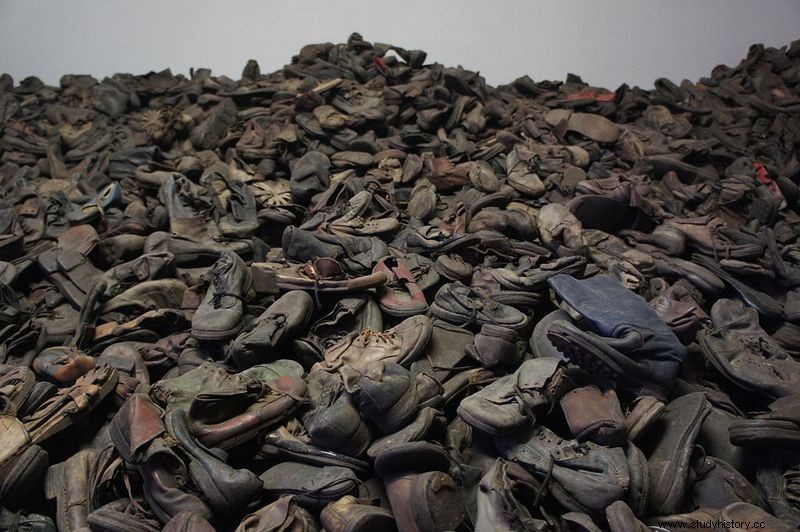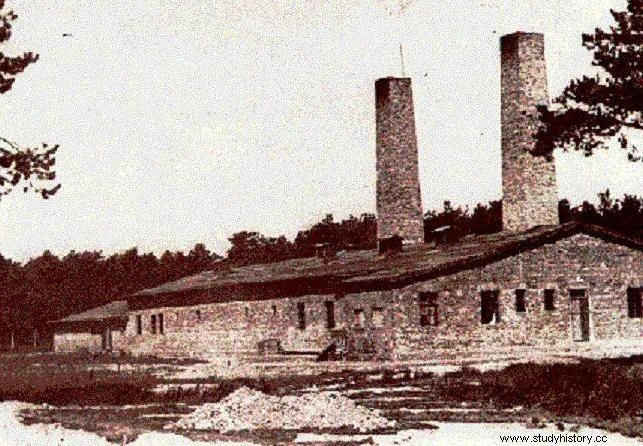KL Auschwitz-Birkenau - a death factory and a symbol of the Holocaust. It seems that the main task of the camp was "the final solution of the Jewish question." In Auschwitz, however, as in any self-respecting "enterprise", material gains were also important. And not just any profits.
When we think about Auschwitz, we can see gas chambers and crematorium stoves, followed by prisoners in striped uniforms. We are forgetting the genesis of the parent camp and the purpose of creating its several dozen sub-camps. In the book "Black Earth. The Holocaust as a warning ”, Timothy Snyder writes about the whole complex:
The original purpose of its construction in 1940 was to pave the way to a larger empire in the east […]. The Jews who were sent to Auschwitz [...] were planned to be sent [...] to the East as forced laborers and tortured to work in building the German empire in the conquered Soviet lands.
To build an empire you had to have money for it, and the easiest way to get it was through the camps.

At the beginning of the war, the Germans wanted to use the Jews to build a Nazi empire in the east (source:public domain).
"The legacy of the dead"
Initially, the objects belonging to the prisoners of the concentration camps were deposited in warehouses and handed over to their families at the time of the prisoner's death. In Auschwitz, however, it was most often assumed that there was no possibility of contacting the victim's relatives. Clothes, shoes or valuables called "legacy of the deceased" were automatically confiscated. As Timothy Snyder rightly points out:
The function of the camp changed when the colonial mission of the Nazis gave way to the "final solution" - the subjugation of the Slavs ceased to be a priority and the murder of Jews became an urgent issue.
It was then that the phenomenon of looting reached its apogee. Cattle wagons were carrying not only tens of thousands of Jews to the newly built camp in Birkenau, but also hundreds of thousands of kilograms of their belongings.

It was among others such wagons that the victims of the Holocaust were transported (photo:Agatefilm; license CC ASA 3.0).
Having a vision of settling in a new area, Jews carried food, clothes, quilts, pots and carpets, as well as specialized equipment in the permitted 30 kilograms of luggage. Among the most original are dental chairs, X-ray machines and watchmaking tools. Everything was already confiscated on the camp ramp.
Rich - like in Canada
The stolen property was stored in barracks called "warehouses of movables" ( Effektenlager ), and in the camp dialect "Canada", because this country was associated with wealth by prisoners.
Some goods, incl. food or clothes were allocated to the functioning of the camp. The best products were sent to the Reich, handed over to displaced persons and Volksdeans.

The article was based, inter alia, on the book by Timothy Snyder entitled "Black ground. The Holocaust as a warning ”(Znak Horyzont 2015).
Care was taken to ensure that the clothes were disinfected and had no blood stains or damage. Furs were given to Wehrmacht soldiers fighting in the East . The rest of the looted property, in particular money and valuables, was handed over to the Reichsbank.
On April 30, 1944, two parcels were sent from Auschwitz containing, among others, PLN 124,940, 20,415 rubles, 1,858 Romanian lei, 825 Belgian francs, 576 Czech crowns and over 1.5 kg of gold and 4.5 kg of silver , 1.8 g of diamonds, over 66 g of other precious stones. These were only two of several dozen similar packages.
In addition, there were thousands of wagons with clothes and everyday objects. When the camp was liberated, Soviet soldiers found, among others, in "Canada" approx. 370 thousand suits, 837 thousand. women's coats and dresses, 44 thousand. pairs of shoes or 14 thousand. carpets that were not burned or removed.

Thousands of pairs of shoes of the victims murdered in Auschwitz-Birkenau (photo:Bibi595; license CC ASA 3.0).
Teeth are worth their weight in gold
Anything could make money. Even the corpses of those murdered in the gas chambers were a source of valuables. The most valuable raw material turned out to be teeth, or rather the metals from which they were made.
Already in 1940 at the Dental Institute of the University of Wrocław a doctoral thesis was defended " On the possibility of reusing gold from the mouths of the dead ". On September 23, Himmler issued an official order to remove dental gold from the bodies of concentration camp prisoners.
In Auschwitz, tooth extraction was performed by members of the Sonderkommando and dentists from camp hospitals. There are reports that prove the scale of the practice. Only in about 200 days in 1942, over 16,000 people were plucked away. teeth made of gold and other metals.

In an effort to maximize profits, the Germans established special goldsmith workshops in the camp's crematoria to obtain dental gold (source:public domain).
There are even special goldsmith workshops in the crematoria ( Goldarb ) dealing with the smelting of the obtained gold. In early 1944, members of the camp resistance movement reported that within a month the SS authorities obtained as much as 10-12 kg of gold from the teeth of their victims.
Hair stockings
Another example of the Germans' macabre prudence was the use of the hair of the victims. Both those beheaded by those working in the camp and those belonging to gassed women. Special commandos dealt with collecting the hair, carefully disinfecting and drying it.

The article was based, inter alia, on the book by Timothy Snyder entitled "Black ground. The Holocaust as a warning ”(Znak Horyzont 2015).
The "raw material" obtained in this way was sent to factories, where it was used to make felt, yarn or stockings for submarine crews. After the liberation of the camp, over 7,000 people were found. pounds of human hair. However, it is difficult to assess how much was earned from this practice, as in the case of human ashes and bones, which were used as fertilizer.
Camp Geese
The most important way of earning money, however, was to use cheap labor. Initially, the slave labor of the prisoners was to ensure the camp's self-sufficiency, and at the same time it was an efficient tool of extermination. In 1940, high hopes were placed also in the development of agriculture near the camp. Rudolf Höss reported to Himmler:
Auschwitz will be a test station for the East. There are opportunities there that we have not had in Germany so far. There are enough working forces. Any necessary agricultural experiment must be carried out there .

Rudolf Höss (center) informed Himmler in 1940 that Auschwitz would be a testing station for the East (source:public domain).
Indeed, soon SS farms were built around the camp, occupying an area of almost 4,000 hectares. hectares . There were six of them in total, including gardens in Rajsko, a poultry farm and a fish farm in Hermęże. Most of their production was used by the camp authorities, but it happened that the best products were sent to the Reich. In January 1945, cattle and geese were evacuated in better conditions than the prisoners.
Uniforms, spoons and seals
Prisoners were also used in industrial enterprises and SS craft workshops. In Oświęcim itself there were, among others, shoemaking and tannery workshops, an artistic smithy, a carpentry shop or an upholstery workshop. They manufactured luxury items for the camp staff and products ordered by the state (e.g. 250,000 spoons ).
Among the SS enterprises, the most important was DAW (Deutsche Ausrüstungswerke), which initially dealt mainly with carpentry. Soon, a surplus of prisoners began to emerge - unfortunately for them at the same time the need to increase the arms industry.
The profiles of the camp enterprises began to change. DAW started producing, among others rubber seals for submarines. Plane dismantling plants were also launched, the work of which was used by both the military and private companies.

Construction of the IG Farben chemical plant in Monowice (source:Bundesarchiv; lic. CC ASA 3.0).
Profit balance without loss
Industrial concerns soon appeared in Auschwitz. The unquestionable priority among them was taken by IG Farbenindustrie, a company producing synthetic rubber. The village of Monowice chose its seat. In the peak period of production, in 1944, the camp established there employed over 11,000 people. prisoners working several hours a day.
Although prison productivity was low due to poor conditions, hunger, and disease, the gains were satisfactory. Smaller SS enterprises gave the state 0.3 marks a day for the working day of one inmate. Meanwhile, IG Farbenindustrie paid, depending on the skill of the prisoner, from 3 to 4 marks, and even more. At its peak, the concern spent tens of thousands of marks a day for this purpose .

IG Farben Buna-Werke plant plan (author:Heromax; license CC ASA 3.0). Click to enlarge.
In 1943 alone, the income of the Third Reich from fees for the work of Auschwitz prisoners amounted to approximately 15–20 million marks. In 1944, this sum doubled. Considering the cost of living of prisoners of 1.34 marks for men and 1.22 for women, pure state profit accounted for more than half of the revenue. However, in the bills received, the Germans never took into account the suffering and death of hundreds of thousands of camp prisoners.
